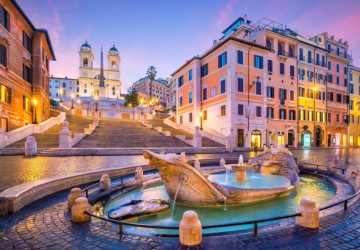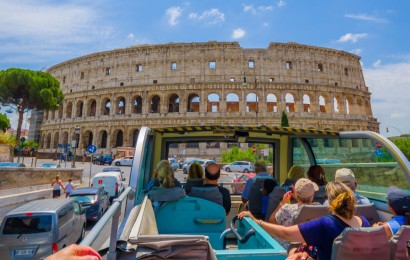Piazza di Spagna is one of the most famous squares in Rome, characterized by the famous Spanish Steps which is one of the most popular places for tourists.
With our Hop On Hop Off tour you can visit the Spanish Steps and all the other main attractions of Rome. Beyond Piazza di Spagna, near the bus stop you can also visit Piazza del Popolo, Villa Borghese, Galleria Borghese and the Zoo.
Why are the Spanish Steps famous?
Piazza di Spagna is one of the most famous squares in Rome that is located in the heart of the historic center of Rome.
The square owes its name to the Palace of Spain, seat of the Spanish Embassy to the Holy See.
Piazza di Spagna is the meeting point for Romans and tourists, who stop on the steps to exchange a chat and relax. For this reason, it is also called the "Salon of Rome".
At the center of the square is the famous Fontana della Barcaccia designed by Pietro Bernini for Pope Urban III. The fountain represents a boat about to sink, and it wants to symbolize the flood of the Tiber occurred in 1598. The stern and bow, represented by two large suns, make the water gush inwards, flanked by the large papal coats of arms with the bees, symbol of the Barberini.
Near the Spanish Steps there are also:
- La Casina Rossa, is the English house museum dedicated to the lives of the romantic poets who spent their stay in Rome near the historic center of the city. These included Keats and Percy B. Shelley and Lord Byron;
- The famous Babington’s tea room, a historic house where you can sip English tea accompanied by a slice of cake. The hall was founded in 1893 by Miss Babington and Miss Cargill;
- In Via del Corso N°8, between 1786 and 1788, lived the German poet Goethe, with his painter friends Johann Heinrich Wilhelm Tischbein. Today, the House of Goethe preserves letters, books and drawings telling the journey in Italy and the Roman stay of the poet, hosts temporary exhibitions and cultural events;
- The House-Museum of the painter Giorgio De Chirico can be visited in Piazza di Spagna n° 31. The artist settled in Rome in 1948 at the age of sixty, in the seventeenth-century Palazzo dei Borgognoni, and today collects a collection of paintings between the forties and fifties, until the sixties of the neo-metaphysical period.
The Staircase of the Spanish Steps

The Spanish Steps were commissioned by Cardinal Pierre Guérin de Tencin and inaugurated on the occasion of the Jubilee of 1725 by Pope John XIII. It was built in order to connect the embassy of the Bourbon of Spain to the Church of Trinità dei Monti and is characterized by 135 steps.
On top of the staircase is the spectacular Church of Trinità dei Monti, a structure of the sixteenth century in Gothic style. It was built in the 15th century at the behest of the French King Charles VIII as a sign of recognition to Saint Francis of Paola for having assisted his father, King Louis XI, before his death. Trinità dei Monti is one of the 5 Francophone Catholic churches in Rome. Inside there are works of extraordinary beauty such as: the Deposition of the Cross and the Assumption of Daniele de Volterra.
In 1789, at the behest of Pope Pius VI, the Sallustian obelisk was placed in front of the church. Entirely made of red granite with a height of 1391 cm.
What to see around the Spanish Steps
Around Piazza di Spagna you can admire other undisputed architectural beauties.
Piazza del Popolo
Piazza del Popolo is a famous square in Rome located at the foot of the Pincio. At the top of the square are the 3 main streets of the historic center of Rome: Via del Babuino, Via di Ripetta and Via del Corso.
At the center of the square, we find the large obelisk Flaminio, about 24 meters high built at the time of the pharaohs Ramesses II and Merneptah.
Villa Borghese
Villa Borghese, a large park of about 80 hectares. He was commissioned by Cardinal Scipione Borghese to Flaminio Ponzo and his pupil Giovanni Vasanzio.
Inside the villa there are monuments, sculptures and buildings made by artists of the baroque, neoclassical and eclectic eras.
The villa also houses the Cinema dei Piccoli (the smallest cinema in the world) and the Zoo of Rome, the current Bioparco and Civic Museum of Zoology.
The Bioparc of Villa Borghese
The Zoological Garden of Rome was inaugurated in 1911, by the architect and trainer Carl Hagembeck who, for the first time in history decided to change the conception of the zoo, replacing the cages with large green spaces bordered by ditches. So in a few years, the zoo of Rome became one of the most important in Europe, and among the oldest in Italy.
In 1994 the Zoo of Rome was transformed into Bioparco, according to a project in which scientific research is applied to the protection of animals and nature, and according to the international WWF organization. Currently it houses about 1200 animals of about 150 species and is located directly in Villa Borghese and walking inside we can meet lions, tigers, giraffes, owls, chimpanzees, brown bears and a large reptile house.
In the Bioparco there is also the Area of the world’s smallest monkeys and rhinos. Finally a wonderful Blue Area, which includes the habitats of grey seals, penguins and California sea lions.

